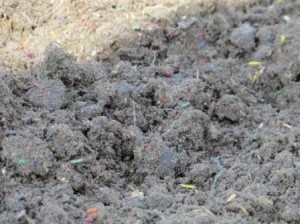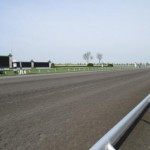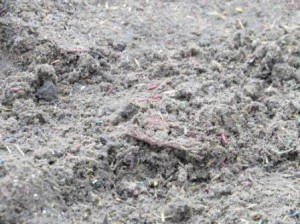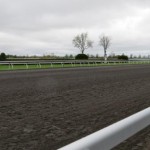Synthetic Tracks
Having just returned from a visit to Keeneland race track in Lexington, Kentucky, I thought it was a good time to discuss the various surfaces that Thoroughbred horses race on. The traditional surfaces in North America are dirt and grass, with the highest value Stakes races held on the dirt. For example, the Triple Crown is run exclusively over dirt surfaces.
Keeneland however, has a Synthetic surface made of a mixture of silica sand, recycled fibers (carpet and spandex) and recycled rubber/pvc. I took a close-up picture to the right to show it’s unique texture. This picture was taken on a warm and sunny day, with very little moisture in the track. Below is a picture of the stretch run taken the same day.
Notice that from a distance it has the appearance of a dirt surface. As I explained in a prior post (Main Tracks), race tracks have either a main dirt track or main synthetic track. The introduction of Synthetic surfaces is fairly recent, and not without some controversy. Some argue that it is safer for the horse and jockey. Others claim that it makes it harder to handicap, thereby decreasing betting dollars and hurting the game. There are many opinions on this topic, but for now I’ll just leave it as a point of discussion.
I believe one point that is less debatable is the impact that wet weather has on a dirt track versus a synthetic track. There is no doubt that synthetic surfaces absorb moisture much better than a dirt track. I took the picture to the right of the same Keeneland surface 24 hours after the above picture and following heavy rainfall for several hours just prior to taking the picture.
You can see that the surface is not significantly different. Maybe a little pressed down, but no standing water. What this means is that both horse and jockey don’t get mud splattered all over them during the course of the race, as they do on a wet dirt track.
The picture to the left was taken of the stretch run at Keeneland moments after the above close-up picture of the “wet” surface. You can see that it looks very similar to the dry surface the day before the rain. This is a main point made by many advocates of synthetic surfaces; that of a consistent and dependable racing surface regardless of the weather. As someone who travels long distances to witness live racing, I must admit there are times when I appreciate knowing that the weather will not greatly impact my visit to a race track that has a synthetic surface.
This is especially true when the rain is heavy enough to knock the races off the turf. When a significant amount of rainfall occurs, most tracks will take races originally scheduled on the turf course and move them to the main track. When the main track is dirt it results in many trainers removing (scratching) their horse from the race. This is because the two surfaces are very different, and many horses prefer turf over dirt.
On the other hand, synthetic surfaces tend to be more like turf than dirt, and as a result less trainers scratch their horses when a race is taken off the turf course, and moved to synthetic. For example, on the day of the rain from the above pictures, three races were taken off the turf course and moved to the main synthetic surface. Those three races still managed to start 7,9, and 10 horses. I suspect that’s several more than would have run, had the races been switched to a dirt (and likely sloppy) surface.
In a future article we’ll get into how the different surfaces and track conditions are presented in the Past Performances (PPs) of the Daily Racing Form.
Update: October 2014
Over the summer of 2014, the synthetic surface at Keeneland was replaced with a dirt surface. Also, it was announced that beginning in 2015, Del Mar (in California) would also be replacing their synthetic surface with dirt.





One comment on “Synthetic Tracks”